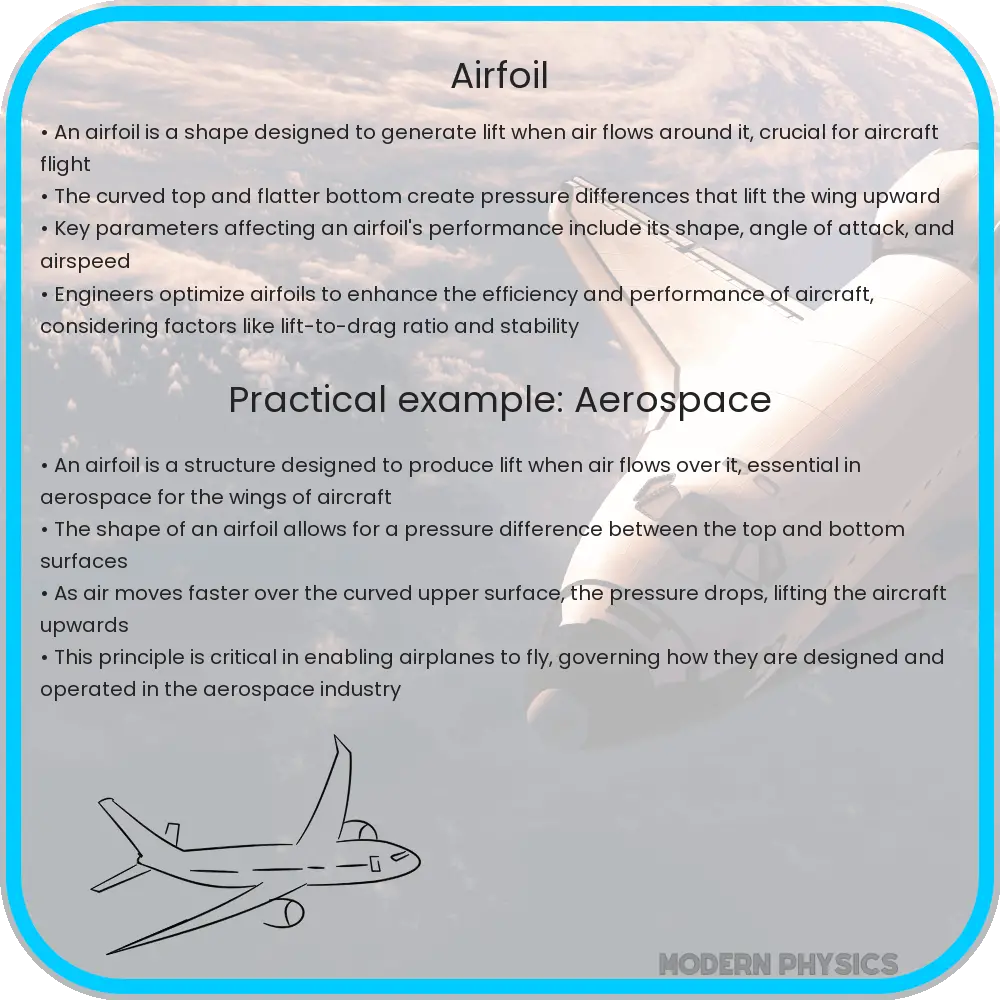Explore the essentials of airfoil efficiency in aviation, focusing on lift, drag reduction, advanced materials, and sustainable design innovations.

Airfoil Efficiency: Exploring Lift and Drag Reduction
The science of airfoil efficiency is pivotal in aeronautical engineering, focusing on maximizing lift while minimizing drag. This article delves into the principles of lift, drag reduction, and innovative airfoil design, highlighting their critical roles in modern aviation.
Understanding Lift in Airfoil Design
Lift is the upward force that allows an aircraft to ascend and remain airborne. It is generated by airfoils, which are structures designed to manipulate airflow. The shape of an airfoil is crucial in creating a pressure difference between its upper and lower surfaces. According to Bernoulli’s principle, faster airflow over the top surface creates lower pressure compared to the slower-moving air under the airfoil, resulting in lift.
Drag Reduction Techniques
While lift is essential for flight, drag is a resistive force that must be overcome. Drag reduction is therefore a key focus in airfoil design. Engineers employ various strategies to minimize drag, including:
- Streamlining Airfoil Shapes: Optimizing the shape of the airfoil to reduce resistance and turbulence.
- Laminar Flow Control: Maintaining smooth airflow over the airfoil surface to prevent the formation of turbulent eddies.
- Vortex Generators: Small, strategically placed devices on the airfoil surface to control airflow and reduce separation drag.
Innovative Airfoil Designs
Recent advancements in computational fluid dynamics (CFD) have led to innovative airfoil designs that offer superior efficiency. These include:
- Variable Geometry Airfoils: Airfoils that can change shape in response to flight conditions, optimizing performance across a range of speeds and maneuvers.
- Adaptive Surfaces: Incorporating materials and mechanisms that allow the airfoil surface to adjust, improving lift-to-drag ratios.
These cutting-edge designs not only enhance the performance of aircraft but also contribute to fuel efficiency and reduced environmental impact. The continuous evolution of airfoil technology demonstrates the intersection of aerodynamics, material science, and environmental stewardship in modern aviation.
Conclusion
In conclusion, airfoil efficiency is a dynamic field that balances the physics of lift and drag with the demands of modern aviation. Through innovative design and sophisticated engineering, airfoils continue to evolve, pushing the boundaries of aerospace technology.
Advancements in Airfoil Materials and Environmental Impact
The evolution of airfoil efficiency extends beyond design to the very materials used in construction. Advanced composites and alloys have revolutionized airfoil manufacturing, offering strength, flexibility, and reduced weight. These materials contribute significantly to overall efficiency, impacting both lift and drag characteristics.
Composite Materials in Airfoil Construction
Composite materials, such as carbon-fiber-reinforced polymers, are increasingly used in airfoil construction. These materials offer high strength-to-weight ratios, essential for efficient flight. Their adaptability allows for more aerodynamic shapes and structures, reducing drag and improving lift.
Environmental Considerations in Airfoil Design
With growing concerns over aviation’s environmental impact, airfoil efficiency is also being viewed through the lens of sustainability. Efficient airfoils contribute to lower fuel consumption and reduced greenhouse gas emissions. The aviation industry is thus focused on designs that not only improve performance but also minimize ecological footprints.
The Future of Airfoil Technology
The future of airfoil technology lies in the integration of smart systems and materials. Concepts such as morphing wings and active flow control are being explored. These innovations aim to adapt the airfoil’s shape in real-time, responding to changing flight conditions for optimal performance. Additionally, the integration of sensors and AI could lead to airfoils that autonomously adjust to maximize efficiency and safety.
Conclusion
In conclusion, airfoil efficiency is a multifaceted field encompassing aerodynamic design, advanced materials, and environmental considerations. The continuous advancements in airfoil technology not only enhance aircraft performance but also contribute to more sustainable aviation practices. As we look to the future, the integration of smart technologies and innovative materials promises to further revolutionize airfoil efficiency, playing a pivotal role in the evolution of aerospace engineering.
